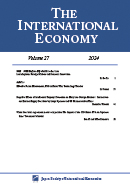Current issue
Displaying 1-5 of 5 articles from this issue
- |<
- <
- 1
- >
- >|
Cover
-
2024 Volume 27 Pages Cover-
Published: 2024
Released on J-STAGE: March 20, 2025
Download PDF (130K)
2022 JSIE Kojima Kiyoshi Prize Lecture
-
2024 Volume 27 Pages 1-23
Published: 2024
Released on J-STAGE: March 20, 2025
Advance online publication: October 19, 2024Download PDF (1373K)
Articles
-
2024 Volume 27 Pages 24-40
Published: 2024
Released on J-STAGE: March 20, 2025
Advance online publication: July 26, 2024Download PDF (693K) -
2024 Volume 27 Pages 41-51
Published: 2024
Released on J-STAGE: March 20, 2025
Advance online publication: February 14, 2025Download PDF (327K) -
2024 Volume 27 Pages 52-68
Published: 2024
Released on J-STAGE: March 20, 2025
Advance online publication: March 07, 2025Download PDF (1126K)
- |<
- <
- 1
- >
- >|
